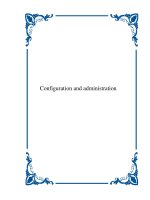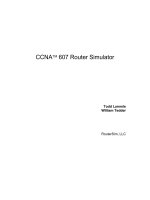Tài liệu Telecommunications and Networking ppt
Bạn đang xem bản rút gọn của tài liệu. Xem và tải ngay bản đầy đủ của tài liệu tại đây (273.16 KB, 96 trang )
CBK REVIEW - August
1999
E
Telecommunications and
Networking
Note: these are slides that were part of a CISSP prep
course that I partly developed and taught while I was
with Ernst and Young.
While these slides are dated – August 1999 - the core
information is still relevant.
Contact me w/ any questions or comments –
Ben Rothke, CISSP
CBK REVIEW - August
1999
E
Upon completion of this lesson, you will:
Explain and understand the OSI model
Identify network hardware
Understand LAN topologies
Know basic protocols - routing and routed
Understand IP addressing scheme
Understand subnet masking
Understand basic firewall architectures
Understand basic telecommunications security
issues
Objective
CBK REVIEW - August
1999
E
Course Outline
•
Intro to OSI model
•
LAN topologies
•
OSI revisited
–
hardware
–
bridging,routing
–
routed protocols, WANs
•
IP addressing, subnet masks
•
Routing Protocols
CBK REVIEW - August
1999
E
OSI/ISO ??
•
OSI model developed by ISO, International Standards
Organization
•
IEEE - Institute of Electrical and Electronics Engineers
•
NSA - National Security Agency
•
NIST - National Institute for Standards and
Technology
• ANSI - American National Standards Institute
•
CCITT - International Telegraph and Telephone
Consultative Committee
CBK REVIEW - August
1999
E
OSI Reference Model
Open Systems Interconnection Reference
Model
Standard model for network communications
Allows dissimilar networks to communicate
Defines 7 protocol layers (a.k.a. protocol stack)
Each layer on one workstation communicates with
its respective layer on another workstation using
protocols (i.e. agreed-upon communication
formats)
“Mapping” each protocol to the model is useful for
comparing protocols.
CBK REVIEW - August
1999
E
OSI MODEL DIAGRAM
Provides data representation between systems
Provides data representation between systems
Establishes, maintains, manages sessions
Establishes, maintains, manages sessions
example - synchronization of data flow
example - synchronization of data flow
Provides end-to-end data transmission integrity
Provides end-to-end data transmission integrity
Switches and routes information units
Switches and routes information units
Provides transfer of units of information to other
Provides transfer of units of information to other
end of physical link
end of physical link
Transmits bit stream on physical medium
Transmits bit stream on physical medium
6
6
5
5
4
4
3
3
2
2
1
1
Provides specific services for applications such as
Provides specific services for applications such as
file transfer
file transfer
7
7
Application
Application
Presentation
Presentation
Session
Session
Transport
Transport
Network
Network
Data Link
Data Link
Physical
Physical
Developed by the International Standards Organization
Mnemonic: All People Seem To Need Data Processing
CBK REVIEW - August
1999
E
OSI Reference Model
Data Flow
6
6
5
5
4
4
3
3
2
2
1
1
7
7
Applicatio
Applicatio
n
n
Presentation
Presentation
Session
Session
Transport
Transport
Networ
Networ
k
k
Data Link
Data Link
Physical
Physical
CLIENT
SERVER
D
a
t
a
t
r
a
v
e
l
s
d
o
w
n
t
h
e
s
t
a
c
k
Through the network
Then up the receiving stack
6
6
5
5
4
4
3
3
2
2
1
1
7
7
Applicatio
Applicatio
n
n
Presentation
Presentation
Session
Session
Transport
Transport
Networ
Networ
k
k
Data Link
Data Link
Physical
Physical
As the data passes through each layer on the client information about that
layer is added to the data This information is stripped off by the
corresponding layer on the server.
CBK REVIEW - August
1999
E
OSI Model
•
Everything networked is covered by OSI
model
•
Keep model in mind for rest of course
•
All layers to be explored in more detail
CBK REVIEW - August
1999
E
SECTION
•
LAN TOPOLOGIES
–
Physical Layer
•
EXAMPLE TYPES
CBK REVIEW - August
1999
E
LAN Topologies
•
Star
•
Bus
•
Tree
•
Ring
CBK REVIEW - August
1999
E
Star Topology
•
Telephone wiring is one common
example
–
Center of star is the wire closet
•
Star Topology easily maintainable
CBK REVIEW - August
1999
E
Bus Topology
•
Basically a cable that attaches many
devices
•
Can be a “daisy chain” configuration
•
Computer I/O bus is example
CBK REVIEW - August
1999
E
Tree Topology
•
Can be extension of bus and star topologies
•
Tree has no closed loops
CBK REVIEW - August
1999
E
Ring Topology
•
Continuous closed path between
devices
•
A logical ring is usually a physical star
•
Don’t confuse logical and physical
topology
MAU
CBK REVIEW - August
1999
E
Network topologies
Topology Advantages Disadvantages
Bus
•
Passive transmission medium
•
Localized failure impact
•
Adaptive Utilization
•
Channel access technique
(contention)
Star
•
Simplicity
•
Central routing
•
No routing decisions
•
Reliability of central node
•
Loading of central node
Ring
•
Simplicity
•
Predictable delay
•
No routing decisions
•
Failure modes with global effect
CBK REVIEW - August
1999
E
LAN Access Methods
•
Carrier Sense Multiple Access with
Collision Detection (CSMA/CD)
–
Talk when no one else is talking
•
Token
–
Talk when you have the token
•
Slotted
–
Similar to token, talk in free “slots”
CBK REVIEW - August
1999
E
LAN Signaling Types
•
Baseband
–
Digital signal, serial bit stream
•
Broadband
–
Analog signal
–
Cable TV technology
CBK REVIEW - August
1999
E
LAN Topologies
•
Ethernet
•
Token Bus
•
Token Ring
•
FDDI
CBK REVIEW - August
1999
E
Ethernet
•
Bus topology
•
CSMA/CD
•
Baseband
•
Most common network type
•
IEEE 802.3
•
Broadcast technology - transmission
stops at terminators
CBK REVIEW - August
1999
E
Token Bus
•
IEEE 802.4
•
Very large scale, expensive
•
Usually seen in factory automation
•
Used when one needs:
–
Multichannel capabilities of a broadband
LAN
–
resistance to electrical interference
CBK REVIEW - August
1999
E
Token Ring
•
IEEE 802.5
•
Flow is unidirectional
•
Each node regenerates signal (acts as
repeater)
•
Control passed from interface to interface by
“token”
•
Only one node at a time can have token
•
4 or 16 Mbps
CBK REVIEW - August
1999
E
Fiber Distributed Data
Interface
(FDDI)
•
Dual counter rotating rings
–
Devices can attach to one or both rings
–
Single attachment station (SAS), dual
(DAS)
•
Uses token passing
•
Logically and physically a ring
•
ANSI governed
CBK REVIEW - August
1999
E
WANs
•
WANs connect LANs
•
Generally a single data link
•
Links most often come from Regional Bell
Operating Companies (RBOCs) or Post,
Telephone, and Telegraph (PTT) agencies
•
Wan link contains Data Terminal Equipment
(DTE) on user side and Data Circuit-Terminating
Equipment (DCE) at WAN provider’s end
•
MAN - Metropolitan Area Network
CBK REVIEW - August
1999
E
OSI Model Revisited
•
Physical
•
Data Link
•
Network
•
Transport
•
Session
•
Presentation
•
Application
CBK REVIEW - August
1999
E
Physical Layer
•
Specifies the electrical, mechanical,
procedural, and functional requirements for
activating, maintaining, and deactivating
the physical link between end systems
•
Examples of physical link characteristics
include voltage levels, data rates,
maximum transmission distances, and
physical connectors









